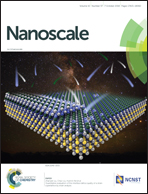Flexible multi-wavelength photodetector based on porous silicon nanowires†
Abstract
Porous silicon nanowires (PSi NWs) responding to red, green and blue lights simultaneously are reported in this study. NWs with a diameter of 120 nm were prepared from p-type Si wafer by metal-catalyst-assisted etching. The NWs produced in this manner had an outer porous region consisting of Si nanocrystals small enough to ensure the quantum confinement effect. Hydrazine treatment passivated the porous region by reduction of the surface oxides and the formation of Si–H bonds. The energy band structure of the porous region was a direct transition type, while the emission/absorption energies corresponded to red (1.94 eV), green (2.24 and 2.44 eV) and blue (2.98 eV) light photons. A device structure prepared by suspending 10 PSi NWs between two Al electrodes by dielectrophoresis generated photocurrents upon exposure to red, green and blue lights. The rising and decay times were both 30 μs and the ratio of photocurrent to dark current was 92.0, 59.8 and 24.4 for the blue, green and red lights, respectively. The device could be bent down to the bending radius of 5 mm without any significant deterioration of the photoresponse performances. Further, the device survived repeated bending and unbending over 10 000 cycles with this bending radius, demonstrating its application potential as a flexible device with multiple-wavelength photosensing capabilities.



 Please wait while we load your content...
Please wait while we load your content...